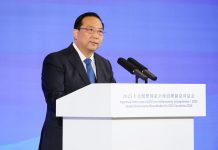LHASA: Passengers carrying luggage of varying sizes, many in Tibetan costumes, chat with each other or bury themselves in their phones while queuing on the platform for their trains.
Such scenes play out daily at the railway station in Lhasa, capital of southwest China’s Tibet Autonomous Region, and stand in stark contrast to what existed 16 years ago.
When the station opened on July 1, 2006, marking the start of the official operation of the Qinghai-Tibet Railway, the region’s first railway line, the platform was more like a tourist attraction packed with visitors.
“Curious about trains, many Tibetans just bought a platform ticket and brought snacks for a picnic here,” said Tsogpa, who has been working at the station since its opening and is now office director of the Lhasa railway station.
With heavy spending on the construction of railway and road facilities, Tibet has seen rapid development and constant improvements to the lives of the locals.
Since 2012, more than 337 billion yuan (about 50.4 billion U.S. dollars) has been spent as fixed-asset investment in Tibet’s transport sector, according to the region’s transport department.
Over the past decade, three railway lines have formed a “Y” shape on the plateau region, with the latest Lhasa-Nyingchi line, the region’s first electrified railway line, kicking off operation on June 25, 2021. The Lhasa railway station, where the three lines meet, has witnessed explosive growth in passenger flow, surging from 2.24 million in 2007 to more than 4 million in 2021.
Bullet trains have brought tourists to the city of Shannan, through which the Lhasa-Nyingchi Railway passes.
In Tashi Chodan, a community in Nedong District of Shannan known for its Tibetan opera, some 30 artists perform for tourist groups from across the country.
Dawa Drolma, 52, one of the performers, said they have shows every night during the peak season.
Dawa Drolma and her family have also refurbished their house into a homestay with six beds. “During the busiest time, all rooms are full,” she said, adding that the opera performance and homestay business bring the family an extra income of more than 50,000 yuan every year.
In 2019, the Nedong district government spent some 50 million yuan for improving the living conditions of the community, including upgrading road facilities. The 2.5-meter-wide cement road was replaced by an 8-meter-wide asphalt one, allowing tourist coaches to arrive at the community.
Over the past 10 years, the per capita disposable income of the community more than doubled to 25,000 yuan a year in 2021, which is largely attributable to the burgeoning tourism industry.
“Tourists would not possibly come without convenient transportation,” said Basang Tsering, Party chief of the community. –Agencies





